Judeo-Bolshevism: Fact from Fiction
an overview of Jewish involvement in the Bolshevik regime through Stalin
The concept of Jewish Bolshevism, or “Judeo-Bolshevism,” is one of the most recognizable antisemitic narratives of the past century, and it remains the subject of immense misunderstandings to this day online. According to the familiar story, Bolshevism is best understood simply as a project of Jewish design with the goal of extending ethnic supremacy over the Christians of Eastern Europe. The episode was so monstrous, and its true authors so unmistakably apparent, that it’s frequently taken for granted as a cornerstone of Jewish “collective guilt.” As E. Michael Jones put it in The Jewish Revolutionary Spirit, “Trotsky's Jewishness brings up the issue of collective responsibility.”
But like so many others parroting this narrative, Jones confuses all sorts of basic facts about the time period, repeatedly mixing up the February and October revolutions for example.1 In this article I seek to clarify and correct such misunderstandings by assembling the relevant information from actual historical sources. I comment on the attitudes toward Bolshevism among the Jewish masses, the Jewish share of the highest bodies of party and state and how it changed over time, the conflicts between Soviet policy and perceived Jewish interests, as well as the origins of the false narrative. This of course could not be a fully comprehensive “takedown” of the conspiracy theory, and popular rumors like the relationship between Jewish finance and the revolution will have to be covered in future articles; I’ve since touched on Stalin’s alleged Jewish affinities and the role of the White émigrés in promoting the disinformation we still see today. The narrow focus of what follows is the relationship between the Bolsheviks and the Jews of the East after October, 1917.
Were the Jews Bolsheviks?
When the October revolution came, the Jewish workers had remained totally passive, and a large part of them were even against the Revolution. The Revolution did not reach the Jewish street. Everything remained as before. —Semyon Dimanstein, chairman of the CPSU’s Jewish section
There are two ways to think about Jewish involvement in Bolshevism: with respect to the Bolsheviks and with respect to the Jews. Firstly, it’s undoubtedly true, as we’ll see, that Jews were substantially overrepresented among the early Bolshevik elites. But it’s also an established fact that the Bolsheviks were never popular among the Jews at large, at least until the other options were taken out of the picture by force. In other words, there’s a marked disparity between the views of the average Jew, or the Jews of the region collectively, and that of a small minority of Jews who managed to rise to the top of the Bolshevik ranks.
The attitudes of the Jewish masses were revealed on a number of occasions by their voting patterns. Rabinovitch’s (2009) analysis of the elections held shortly after the February Revolution concludes that “Jews living in the territories of the former Russian Empire, when given the opportunity to participate in general elections, expressed only marginal support for the Jewish socialist parties and instead voted for parties and coalitions that principally demanded Jewish collective rights within a liberal framework” as can be seen in the provided chart:
A similar pattern was seen in the Jewish voting records for the 1919 Polish legislative election, which “demonstrated the moderate social views of a basically conservative population much more interested in protecting its civil and national rights than in promoting social change,” in the words of one relevant historian. We encounter this again in the 1918 election of the Ukrainian Jewish National Assembly, where the “first three parties [below], comprising over half the entire electorate, were outspokenly bourgeois, whereas the three at the end of the list were socialist parties but were extremely anti-Bolshevik; they received over a third of the vote. The Zeirei-Zion party was a people's socialist party, bridging, as it were, the Right and the moderate Left camps.”
The actual sentiments of the Jewish masses were thus far less sympathetic to leftist radicalism and Bolshevism than occasionally assumed. The real base of popular support for the Bolsheviks electorally came not from the Jewish areas but primarily from the Russian proletariat of the large industrial cities. Richard Pipes summarizes that
while not a few Communists were Jews, few Jews were Communists. When Russian Jewry had the opportunity to express its political preferences, as it did in 1917, it voted not for the Bolsheviks, but either for the Zionists or for parties of democratic socialism. The results of the elections to the Constituent Assembly indicate that Bolshevik support came not from the region of Jewish concentration, the old Pale of Settlement, but from the armed forces and the cities of Great Russia, which had hardly any Jews. The census of the Communist Party conducted in 1922 showed that only 959 Jewish members had joined before 1917.
This last sentence is also noteworthy. In terms of the rank-and-file membership of the Community Party of the Soviet Union (CPSU) itself, which for most of its history was sort of a privilege to obtain, Jews were consistently modestly overrepresented with respect to their proportion of the Soviet population: “Representing just 1.8 percent of the total population in the 1926 census, Jews comprised 5.2 percent of party members in 1922 and 4.3 percent in 1927.” For greater clarity, the following chart compiles ethnic data taken from the 1922 All-Russian Communist Party Census:
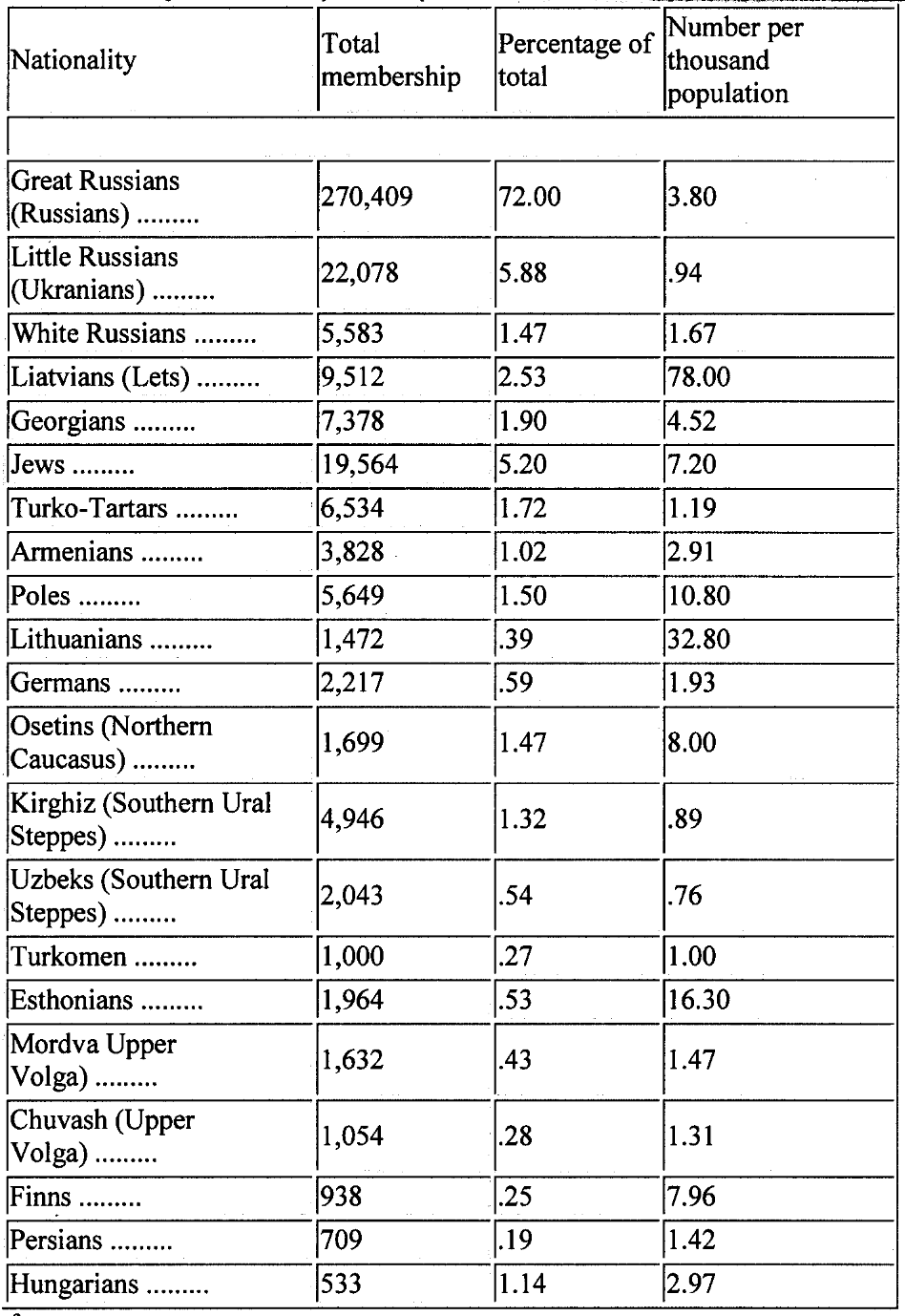
Thus, while 5.2% of the Party was Jewish in 1922 with respect to a population of around 2%, just 7.2 Jews per 1,000 were members. Two additional details should be noted for context:
The Ukrainians, at 21.2% of the population based on the 1926 Census, were seriously underrepresented, naturally boosting the share of the other nationalities.
No fewer than six other ethnic groups were more overrepresented among members than Jews, including Poles, Finns, Lithuanians, Ossetians, Estonians, with Latvians at an incredible 78 Bolsheviks per thousand.
Also note that this data comes from 1922, or toward the close of the Russian Civil War which saw an increase in support for the Bolsheviks and Red Army among Jews. This was of course no organic change of heart. For the Jews of the region, the Civil War was the bloodiest thing they’d ever experienced, culminating in perhaps 100,000 deaths and with most of the worst pogroms committed or instigated by White soldiers themselves. The White Army, and soon the White émigrés, were in fact central to the creation and promulgation of the myths this article is reviewing. Bolshevik forces were themselves not free from sporadic anti-Jewish violence — being “responsible for 8.6 per cent of the Civil War pogroms” — but by and large they stood opposed to antisemitic violence in rhetoric and action.
Were the Bolsheviks Jews?
To avoid unnecessary confusion, we first need to review the structure of the Soviet bureaucracy through Stalin. Although the Soviet Union was a one-party state, Lenin deliberately severed the party itself from governmental institutions, albeit with the former ultimately in control. Since this was a totally contrived system, it was frequently tweaked and altered through the years, meaning things can easily get tricky.
Starting with government:
The USSR was, as the name would have it, a Union of Soviet Socialist Republics, each possessing an individual government subordinate to the overarching Soviet government. The Russian Soviet Federative Socialist Republic (RSFSR), being the largest, was naturally most prominent.
When one refers to the Russian or Soviet “government” of this era, what they typically mean is its Council of People’s Commissars (CPC, also called Sovnarkom), the commissars presiding over specific policy areas like agriculture or defense, along with the chairman, his deputies, and a couple other, minor positions. There was a CPC for the USSR along with one per each of the republics. Before the USSR’s CPC was established in 1923, however, that of the RSFSR governed the entire state. In 1946, the CPCs were replaced with Councils of Ministers (CM) which functioned similarly.
The USSR’s CPC/CM had a chairman who served as the Soviet Premier, occasionally referred to as their Prime Minister.
The Congress of Soviets, formed in 1922, was the body that appointed these commissars/ministers, and was succeeded in 1936 by the Supreme Soviet. But both bodies were ultimately beholden to the decisions of the Communist Party per the doctrine of democratic centralism.
The Congress of Soviets also elected a Central Executive Committee (not to be confused with the party’s Central Committee discussed later) which held most of the real power and acted between congresses. For the Supreme Soviet, this body was called the Presidium of the Supreme Soviet. Notably, while the CEC had multiple, simultaneous chairmen, the Presidium had only singular, successive chairmen.
Regarding the CPSU:
The party’s Congress was officially to play the definitive role in Soviet affairs, electing Central Committee (CC) members to govern in between sessions (much like the government’s CEC), but in practice it was beholden to whatever de facto leadership was in power at the time. The Congress convened typically every five years, but from 1939 through Stalin’s death it was completely neglected.
The CC housed a few subdivisions of note: the Politburo (Political Bureau) was most important, and under Stalin basically preempted the CC itself; the Orgburo assigned members to various positions and oversaw the execution of party goals; the Secretariat was intended to perform technical, administrative work but came to dictate day-to-day party activities, and its leader, the General Secretary (otherwise known as the Technical, Responsible, or First Secretary), was also a member of the Politburo.
“Candidate members” served advisory roles in all these committees and formally comprised the pool of potential committee member replacements, but they had no voting rights by themselves.
Party
The annotated chart above2 provides a chronological look at the Jewishness of the Central Committee and Politburo in the period from the latter’s first convocation all the way to Stalin’s death. “Jewishness,” here, is defined simply as possessing at least one Jewish parent; this means the Russian-Jewish Mischling Kamenev is counted as Jewish, but the quarter-Jewish Lenin is not.3
Of all the members of the Politburo from its formal establishment in 1919 to the end, there were four individual Jews (Trotsky, Kamenev, Zinoviev, and Kaganovich), along with four Georgians, 11 Ukrainians, and 89 Russians. If we go earlier to its de facto beginning at the sixth party Congress up until 1919, there were 14 unique members, fully half of whom were Jewish (Trotsky, Kamenev, Zinoviev, Sverdlov, Ioffe, Uritsky, Sokolnikov); of the 26 total member positions for this period, half were also occupied by Jews. Of all the bodies of power, this earliest period of the Communist Party saw the most extreme Jewish overrepresentation. In three brief periods, there was even a technical Jewish majority in the small Politburo compositions.
The 1992 book The Rise and Fall of the Soviet Politburo provides a useful chart of ethnic representation in the Politburo at five-year periods4:
Coming to terms with the Central Committee as body of political power to which even the Politburo was technically beholden, a couple of investigations have been carried out for this early period:
Mawdsley (1995)5 examined the 78 full or candidate members of the CC from 1917–April, 1923 — the “first generation of the Soviet elite” — and found that “[o]nly half (38/78) were Great Russian. The second largest ethnic group were the Jews, who numbered 13 (17 per cent). Eight more were Ukrainians, eight and five were from the minorities of the Baltic and the Transcaucasus respectively. Six further individuals belonged to as many different nationalities.”
Riga’s (2008)6 analysis provides greater clarity on questions of ethnicity, analyzing CC members ostensibly from a slightly greater time period7 and finding roughly the same Jewish proportion as Mawdsley: 15%.
Mind you, both Mawdsley and Riga deal with unique members, while the available positions in the CC from year to year obviously frequently reused members. The chart displayed at the beginning of this section shows a consistently higher proportion of Jews in the CC session-to-session (although at no point numerical dominance as with the Politburo), likely reflecting the fact that Jewish Bolsheviks tended to reappear at a greater rate than non-Jewish Bolsheviks, although the data also excludes candidate members unlike either Mawdsley or Riga. Either way, it’s clear that Jews tended to be more successful in the Bolshevik apparatus.
A handful of Jews including Trotsky, Zinoviev, and Kamenev remained among the most prominent Bolsheviks throughout the early period, although eventually they were infamously purged by that notorious Georgian8, Joseph Stalin. The Jewish share of the Politburo diminishes greatly under the reign of Stalin, with the removal of all the Jews by the mid-1920s up until Kaganovich is installed in 1930. Jews become, in fact, underrepresented (~0.7% or six of 851 total post-Stalin elite in Mawdsley’s terms9) in the post-Stalin USSR.
Finally, regarding the other factions within the Central Committee, both were rather minimally Jewish:
State
Compared with the Communist Party, Jewish representation in the Russian and Soviet governments was much more modest. We’ll start with a timeline of central leadership positions in the USSR:
Of the 12 Premiers, none were Jews.
Of the 11 chairmen of the Presidium of the Supreme Soviet… Edit 2025: none were Jewish? At the time I believed Andropov was half-Jewish, but that seems not to be the case, so disregard that part of the graphic I suppose. Regarding the earlier Soviet CEC chairmen, nine men held the role in overlapping terms; none of them were Jewish.
Of the 11 General Secretaries of the USSR, one was Jewish: Yakov Sverdlov (1918—1919)
and Yuri Andropov (Nov. 1982—Feb. 1984).Of the 19 chairmen of the RSFSR’s CPC/CM, none were Jews.
Of the 16 chairmen of the CEC/Presidium of the Supreme Soviet of the RSFSR, the first two were Jewish: Lev Kamenev (Oct.—Nov. 1917), Yakov Sverdlov (—Mar. 1919).
In the first composition of the Russian government (below), Trotsky was the only Jewish commissar, serving as People’s Commissar of Foreign Affairs. According to Vedomosti’s article correcting that bizarre comment Putin once made, “In the government of the RSFSR from 1917–1922, Jews were 12% (six people out of 50).”

As noted earlier, the RSFSR’s CPC reigned supreme until the USSR’s was formed in 1923. We observe the same minimal Jewish presence in the first Soviet government, given below:
On pages 76–83 of The Jews of the Soviet Union, Benjamin Pinkus surveys these themes. Regarding the membership of the USSR’s CEC in 1929, he finds “the number of Jews on this body was 55 [9%], Russians 402, Ukrainians 95, Latvians 26, Poles 13, and Germans 12,” a slight decline from 1927. By 1937, “47 Jews were elected to the Supreme Soviet out of 1,143 delegates—that is, 4.1% of the delegates of both Houses—while their percentage of the whole population of the Soviet Union was less than 2%.” Pinkus also provides a well-known figure for the “ruling élite of the Soviet Union in the mid 1920s”: “of the 417 people … twenty-seven (that is 6%) were Jews.” I think this provides a helpful perspective, though the figure would necessarily change depending on how one defines “élite.”10 Pinkus also notes that the Jewish share of his (undefined) “economic élite” of the 1920s was “as high as ten per cent.”
Secret Police
The Soviet security infrastructure was even more convoluted and subject to change than the other bodies of state. As briefly as possible: the agency began as the RSFSR’s dreaded Cheka in 1917. In 1922 the Cheka becomes the GPU, subsumed by the RSFSR’s NKVD, its internal affairs ministry. By the next year, the GPU becomes the OGPU, independent of the NKVD. In 1934 the OGPU becomes the GUGB, subsumed now by the USSR’s NKVD. In 1943 the GUGB becomes the NKGB, independent of the NKVD. In 1946 the NKGB becomes the MGB, which by 1953 has become the MVD and by the next year the KGB, which stands until the dissolution of the USSR. Below is the consecutive leadership of each of these organizations, Jewish figures simply given in blue (again, disregard Andropov).
Some statistics for Jewish participation in these organizations can be obtained from Krichevsky's “Jews in the apparatus of the Cheka-OGPU in the 20s,”11 digitally reproduced in parts one and two. Accordingly, under the Cheka of the Polish Felix Dzerzhinsky, only a slight Jewish presence is detected along with a striking Latvian one: in 1918 while 4.3% of commissars (N = 70) were Jewish, 54.3% were Latvian, an ethnic minority comprising not 1% of the total population. Jews comprised 8.6% of the 154 senior officials, or the “heads and secretaries of departments, commissioners, investigators and their deputies, instructors, etc.,” and 19.1% of investigators and their deputies (42); Latvians were 52.7% and 33.3%, respectively. Regarding the rank and file, or the ~50,000 members of the provincial Cheka offices, 9.1% were Jews. Of course, ethnic representation was heterogeneous, and for Jews was most pronounced among investigators and in the regions of the former Pale of Settlement. On the whole, however, and contrary to the popular conception of the vengeful Jewish Chekist, Jews were not actually all that salient. Budnitskii’s Russian Jews between the Reds and the Whites, 1917–1920 provides the Cheka leadership on pages 108–109, observing that “from 1918 to 1920, four Jews served in the highest governing body of the Cheka: Zaks, Messing, Moroz … and Yagoda, who would work in the Cheka from 1920 onwards.”
Things would however change from here as the agencies began selecting more heavily on the basis of educational attainment, Jews being a better-educated demographic: while “14 out of 15 Jews in the leadership of the OGPU apparatus had a secondary and higher education (93%), among the Poles this figure was 8 out of 10 (80%), among Russians, 28 out of 54 (52%), among Latvians, 3 out of 12 (25%).” This leadership amounted to 96 individuals, Jews thus comprising 15.7%. Latvians at 12.5%, while still the most overrepresented, were on their way out of the organization by 1923 as Civil War conditions waned. By 1924 the Central Office (2,402) was 8.49% Jewish and 8.66% Latvian. By 1927 the district department heads (36) were 14.7% Jewish and 10.8% Latvian; leading employees endowed with “Orders of the Red Banner” (34) were 23.5% Jewish and 8.8% Latvian. Personal research (5:50+) by The Problem Gene, an interesting creator who was the inspiration for my study of Boasian anthropology, estimated that by 1929 OGPU leadership was 22% Jewish, 11% Latvian, and 5% Polish. The data altogether is incomplete but suggests a gradual elevation of the Jewish share of Soviet secret police leadership to a high point by the start of the GUGB. The 1934–1941 period is analyzed comprehensively by Russian historians NV Petrov and KV Skorkin; accordingly, Jews comprised an impressive 39% of “high-level officials” at the peak in 1936.
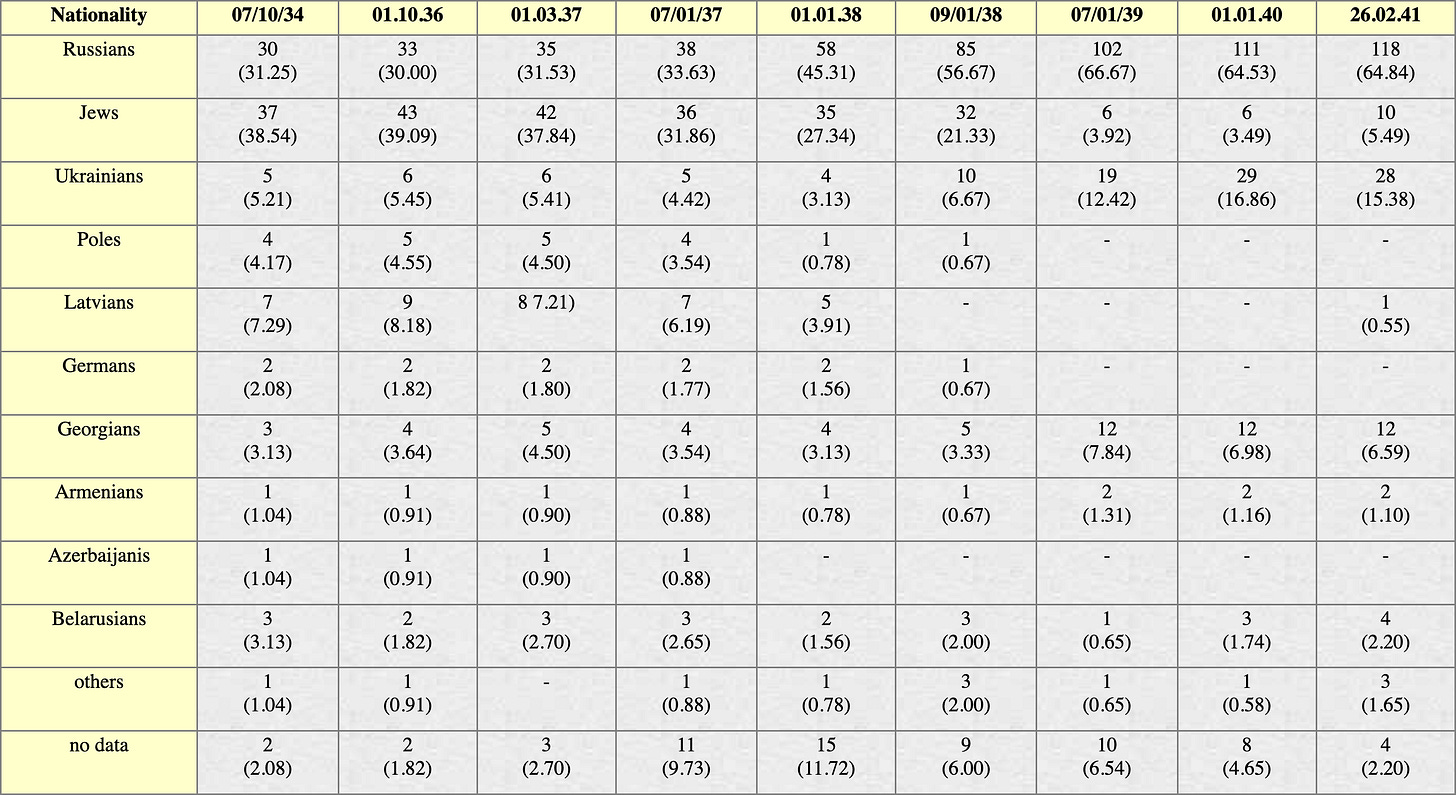
In 1934 the OGPU was replaced by the GUGB and preempted by the NKVD, led by the Jewish Genrikh Yagoda until he was sacked in 1936 and killed along with his family. Jewish representation falls under his successor, the Russo-Latvian Nikolai Yezhov, and plummets to virtually nothing under the Georgian Lavrentiy Beria who takes over in 1938 after Yezhov was similarly purged; it never recovers. Petrov and Skorkin cover the 1938–1939 purges here, noting that many “foreign nationalities” — Jews, Latvians, Poles, Germans — take a hit, excepting Georgians and Ukrainians.
Bolshevism and the Jews
As noted in the introduction to this piece, the Judeo-Bolshevik narrative holds that the Soviet Union, at least in its earlier half, was a vessel for Jewish sadism against and supremacy over non-Jews. It necessarily follows, then, that the USSR was committed to advancing specifically Jewish interests. There are certain ways in which this can be said to be true, i.e., in the Bolshevik opposition to the Tsardom and its identification of antisemitism as a force of reaction. But there were also important ways in which Soviet policy contradicted Jewish interests, some examples of which follow.
Kimerling’s article “Civil Rights and Social Policy in Soviet Russia, 1918–1936” discusses the lishentsy, or “disenfranchised,” status applied in order to legally disadvantage those deemed economically exploitative, depriving them of voting rights and determining “tax obligations, the harshness of legal penalties, [and] access to education and services.” Kimerling notes that among “the national minorities, Jewish areas possessed a singularly high proportion of lishentsy. If the average proportion of lishentsy in the Ukraine was 1.4 percent in 1925-26 and 4.6 percent in 1926-27, then the corresponding figures for Jewish settlements were 23.6 percent and 39.1 percent. … Jews were clearly overrepresented among the disfranchised.”
Leading Bolsheviks regarded Jewishness as an aberrant identity sustained only by the forces of capitalism; under the right conditions it would simply fall away. During the days of the Russian Social Democratic Labour Party, Lenin would frequently clash with the Jewish Bund as its representatives increasingly demanded national autonomy for the Jewish proletariat. In his notes on the Jewish Question, Lenin chides the Bundists and their demands in the harshest terms, summing up with “Whoever directly or otherwise puts forward the slogan of Jewish national culture (however well intentioned he may be) is the enemy of the proletariat, the defender of the old and caste element in Jewry, the tool of the rabbis and of the bourgeoisie.” Stalin was even more direct in Marxism and the National Question: “The question of national autonomy for the Russian Jews consequently assumes a somewhat curious character: autonomy is being proposed for a nation whose future is denied and whose existence has still to be proved!”
The Soviets naturally opposed Jewish traditional and religious life as reactionary. While Russian Orthodoxy was the main focus of the anti-religious campaigns for obvious reasons, the idea promoted at the time that the synagogues were being conspicuously spared from persecution was flatly wrong. The teaching of Hebrew, as the language of Judaism and Zionist revivalism, was banned, the Lubavitch Rebbe was imprisoned and then expelled, and in 1921 all Jewish religious schools were closed.

Despite Candace Owens claiming to have “literally never heard or read about that,” the USSR’s strident opposition to Zionism is very well known. Before being purged itself, the CPSU’s Jewish section was initially tasked with crushing it. Pipes relates: “In September 1919, the Evsektsii shut down the Zionist Central Office and the following year got the Cheka to arrest and exile numerous Zionists. In 1922, the campaign resumed with arrests and trials in Russian and Ukrainian cities. In September 1924, police raids resulted in the detention of several thousand Zionist activists.” There was in fact a brief attempt to bring Israel into Soviet alignment and drive out British regional influence, with the Soviet bloc voting to recognize Israel and then supply it with Czechoslovakian arms, but this collapsed soon enough and the later history of Soviet-US Middle Eastern proxy wars is well documented. Even during this courting period, however, Soviet sentiment was about as pro-Zionist as the Nazis were pro-Bolshevik under the Molotov-Ribbentrop Pact; the Soviets steadfastly refused to let any of their Jews make aliyah, pursued Russification at the expense of Jewish identity, and staged the Doctors’ Plot and Slánský Trial during this time.
Wilton and the Whites
At this point it should be clear that 1. there’s a significant disparity between the Judeo-Bolshevik narrative and reality, and 2. this arose not merely out of confusion or circumstance but through deliberate efforts. The falsified lists of Jewish commissars that still linger around, for example, both demonstrate this fact and lead one to wonder about their origins. As far as I can tell, the most common lists seem to come from The Last Days of the Romanovs by First Red Scare-era British journalist Robert Wilton. In an appendix attached to the Institute for Historical Review’s reprinting of the work, which has ever since circulated on white nationalist websites, IHR director Mark Weber claims the lists are from Wilton’s foreword to the “rare French edition.” The 1921 Paris edition available online actually mentions nothing of the sort, but assuming Weber didn’t simply make all this up himself, Wilton included these details in “order not to leave myself open to any accusation of prejudice” in crafting his fantastical version of the Romanov murders.
In his article, “The Jewish Role in the Bolshevik Revolution and Russia’s Early Soviet Regime,” Weber describes Wilton’s book as “one of the most accurate and complete accounts of the murder of Russia’s imperial family,” providing the following annotated citation:
On Wilton and his career in Russia, see: Phillip Knightley, The First Casualty (Harcourt Brace Jovanovich, 1976), pp. 141-142, 144-146, 151-152, 159, 162, 169, and, Anthony Summers and Tom Mangold, The File on the Tsar (New York: Harper and Row, 1976), pp. 102-104, 176.
But these sources, naturally, fly in the face of Weber’s assertions. Quoting from Summers’ and Mangold’s book:
A Foreign Office communication described Wilton as “inaccurate as to facts”, and a Times memorandum even labelled its own employee as “not quite up to The Times standard either from the point of view of political judgement or style”. Wilton was deeply involved with White Russian politics, and wrote before leaving for Siberia: “I am in touch with a certain Russian organization … and thanks to this fact I would enjoy exclusive channels of information.” . . . Wilton openly leaped on the White Russian bandwagon, becoming a de facto assistant to none other than General Diterikhs. The two men shared a mutual hatred of Bolshevism and Germany, and above all of Jews, a hatred encapsulated in one sentence of the book Wilton was to write about the fate of the Romanovs: “The murder of the tsar, deliberately planned by the Jew Sverdlov (who came to Russia as a paid agent of Germany) and carried out by the Jews, Goloshchokin, Syromolotov, Safarov, Voikov, and Yurovsky, is the act not of the Russian people, but of this hostile invader.” . . . In his definitive book on war reporting, Phillip Knightley of the Sunday Times writes of Wilton: “… he compromised any claim to objective reporting by joining the staff of one of the White Russian generals … it is clear that his part in the intervention on behalf of various White Russian elements made his value as a war correspondent virtually nil.” But in 1920 Wilton’s articles on the Romanov massacre had the full authority of Printing House Square, and carried considerable weight. The articles, and the later book based on them, were major factors in establishing the orthodox assassination version in Britain.
Further, the lists provided in Appendix D were not ones that, as Weber assumes, “Wilton compiled on the basis of official reports and original documents.” Most likely, as I’ve discussed elsewhere, they were copied from the scribblings of White émigrés like Boris Brasol. Robert Wilton, like many of the era’s antisemitic propagandists, was clearly intimately connected to the Bolsheviks’ opponents, the force heavily responsible for the unprecedented destruction of Ukrainian Jewry. Supporters of the White cause had from the start settled on a cynical antisemitism as the most effective means of shoring up its reputation, tethering for the first time the Judeo- to Bolshevism.
As we’ve seen, even despite the propaganda, there was indeed a basis of actual Jewish overrepresentation among party elites at the time. This might have not even been necessary for the emergence of Judeo-Bolshevism as a narrative. The 1881 pogroms, for example, were catalyzed by the assassination of Tsar Alexander II despite there being no such significant presence of Jews in the responsible organization, The People’s Will, or even among Russian revolutionaries broadly at the time, and despite the Tsar being in fact liked by the Empire’s Jews for his liberal reforms; the narrative of a Jewish assassination was simply crafted out of thin air.12 But the historical association that undeniably developed between Jews and the Left extended outside of Russia, beyond the ranks of Bolshevism, and undoubtedly served to make foreign audiences more receptive to the narrative. These themes, however, will have to be carried further in future articles.
TL;DR
The Bolshevik takeover in Russia saw an influx of the empire’s minorities, largely from intellectual backgrounds and the professions, into positions of leadership. Riga’s analysis found that two-thirds of the early Bolshevik elite belonged to an ethnic minority background. Of the ethnic groups, Jews were usually not the most numerous nor even the most overrepresented, but nonetheless were enough of each to have a noteworthy impact on the revolution and early institutions of Soviet power. Jewish representation was significantly more pronounced in the Communist Party leadership than among the commissars of the Russian and Soviet governments, but even that died out by the mid-1920s and never recovered. By the time Nazi partisans were advertising Judeo-Bolshevism the hardest, Jewish participation was far from dominant, and after Stalin, Jews were kept a nonentity among Soviet elites. Oddly enough, the positions most commonly associated with Jews — namely the commissars and Chekists — saw the lowest levels of Jewish representation in the early period.
Sources
Compilation of the members of the Bolshevik and RSDLP Central Committee, Politburo, Orgburo, Committee for Party Control, Central Inspection Commission, Commission for Soviet Control, and Central Control Commission, along with their ethnic backgrounds
All Politburo members over time
Additional collection of links for the members of the sessions of the Central Committee of the Communist Party
Russian collection of the members of all the official bodies of the Communist Party and Soviet government, save the Council of People’s Commissars
Russian collection of all the members of the Council of People’s Commissars over time, though compiled for each separate commissariat, as well as related bodies and organizations
List of the personal composition of all the governments of the RSFSR, in English
Russian collection of all the leaders of high-ranking bodies of power in the RSFSR, USSR, and Communist Party, though lacking their full personal composition
See pages 733–734 of The Jewish Revolutionary Spirit, where Jones says Jewish American financier Jacob Schiff expressed approval at the Bolsheviks taking power, despite the fact he was never a supporter of the Bolsheviks and his comment was regarding the Kerensky government. Jones goes on to claim millions of roubles were raised by “Schiff and Rothschild” in “April 1918” — I’m unsure whether this is even true, but Jones’ own source in fact dates this to the April of 1917, months before the Bolshevik coup!
I used multiple sources to corroborate information. The Skeptik.net list gave basic ethnic information, but was incomplete. There were many members listed without an ethnic identifier (71 of the 125 given for the XIX Congress, for example), so I had to search around the Web to find those whom I could confidently identify as Jewish or non-Jewish, which was a good majority.
Lenin’s maternal grandfather was most likely Jewish, a fact first discovered by his sister after his death, and thus likely unknown to Lenin during his lifetime. Interestingly, this theory also posits that Lenin’s great-grandfather, a Christian convert who had his son baptized, had written a letter to Tsar Nicholas I requesting greater restrictions on the Empire’s Jews. I’m also aware of another theory, at least on the Russian-language Internet, that the grandfather was actually a Russified German.
The book also clarifies important things about the nature of the early Politburo. The year 1919 marks the point where the “history begins” for the institution. Before then, inner circles of the Central Committee had been set up since 1908, but have “not always been recognized as the precursor to the all-powerful Politburo.” The first nominal convocation of October, 1917, for example, never formally convened after it was first assembled, and there’s “no evidence that the Bureau worked during the Bolshevik seizure of power two weeks after its establishment.”
Mawdsley’s findings are also included in a 2000 book he cowrote: The Soviet Elite from Lenin to Gorbachev.
Riga’s findings are also included in a 2012 book she wrote: The Bolsheviks and the Russian Empire.
Mawdsley (N = 78) restricts his analysis up to April of 1923, intentionally excluding “an enlarged Central Committee was elected at the 12th party congress in that month.” It appears Riga (N = 93) includes the full year 1923.
Or, apparently, that notorious Ossetian, at least in part, as is pointed out in the comments of this piece. Also see my post on Stalin.
See Mawdsley’s book mentioned in note 5: p. 109, footnote 42.
Pinkus’ definition includes “the members of the Central Executive Committee, the Party Central Committee, the Presidium of the Executive of the Soviets of the USSR and the Russian Republic, the governments of the Soviet Union and the Russian Republic, the Ministers, and the Chairman of the Executive Committee.”
This source is a classic for investigations into this topic, being cited in works like The Jewish Century and Russian Jews between the Reds and the Whites. Most of the relevant statistics are taken from the included charts.
More can be read about this in Haberer’s Jews and Revolution in Nineteenth Century Russia. One of the six anarchists sentenced death and two of the 31 Executive Committee members were Jewish; police statistics found that among the most serious offenders arrested for political subversion between 1873 and 1877, 6.5% were Jewish. Schapiro’s classic essay “The Role of the Jews in the Russian Revolutionary Movement” also discusses this history; Jews would become overrepresented among leftist radicals starting in the 1880s.










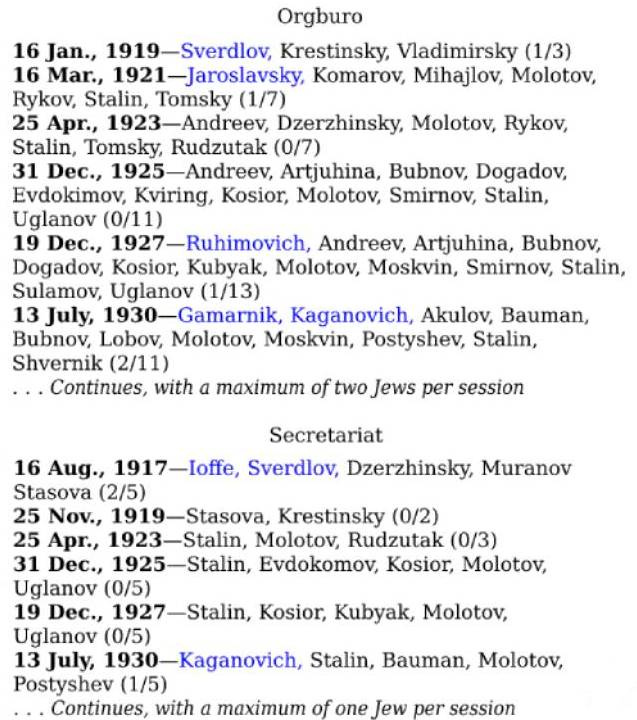

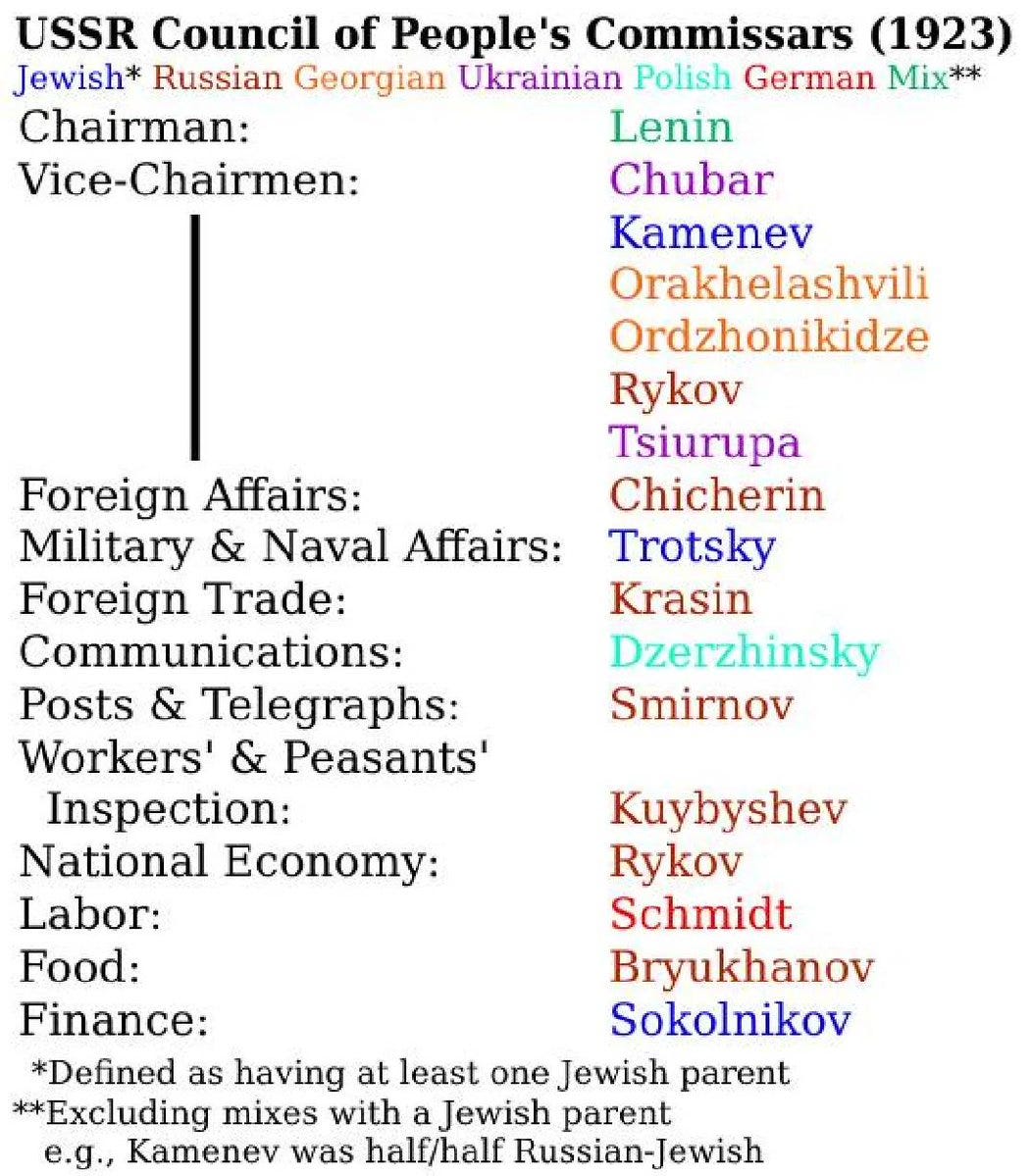




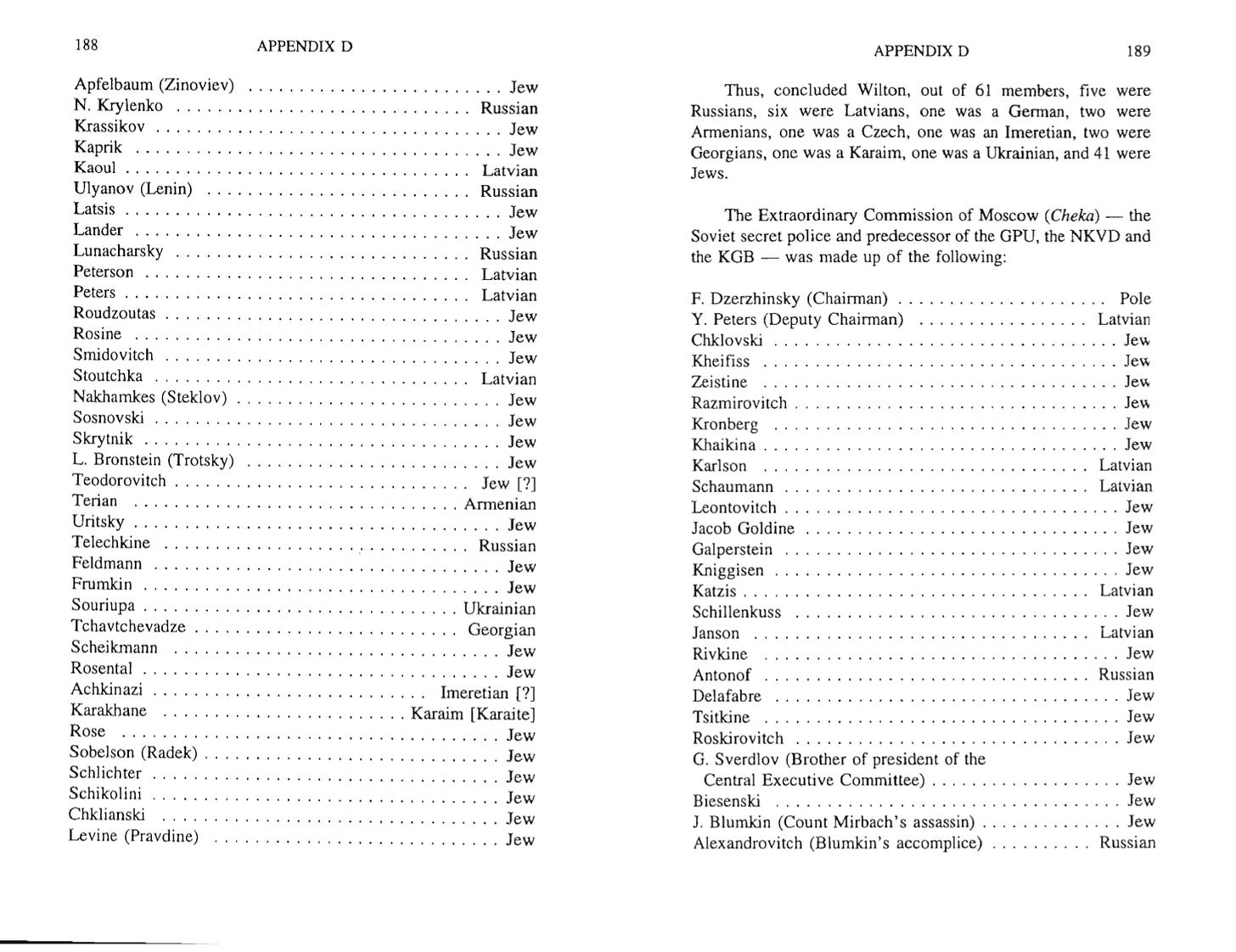
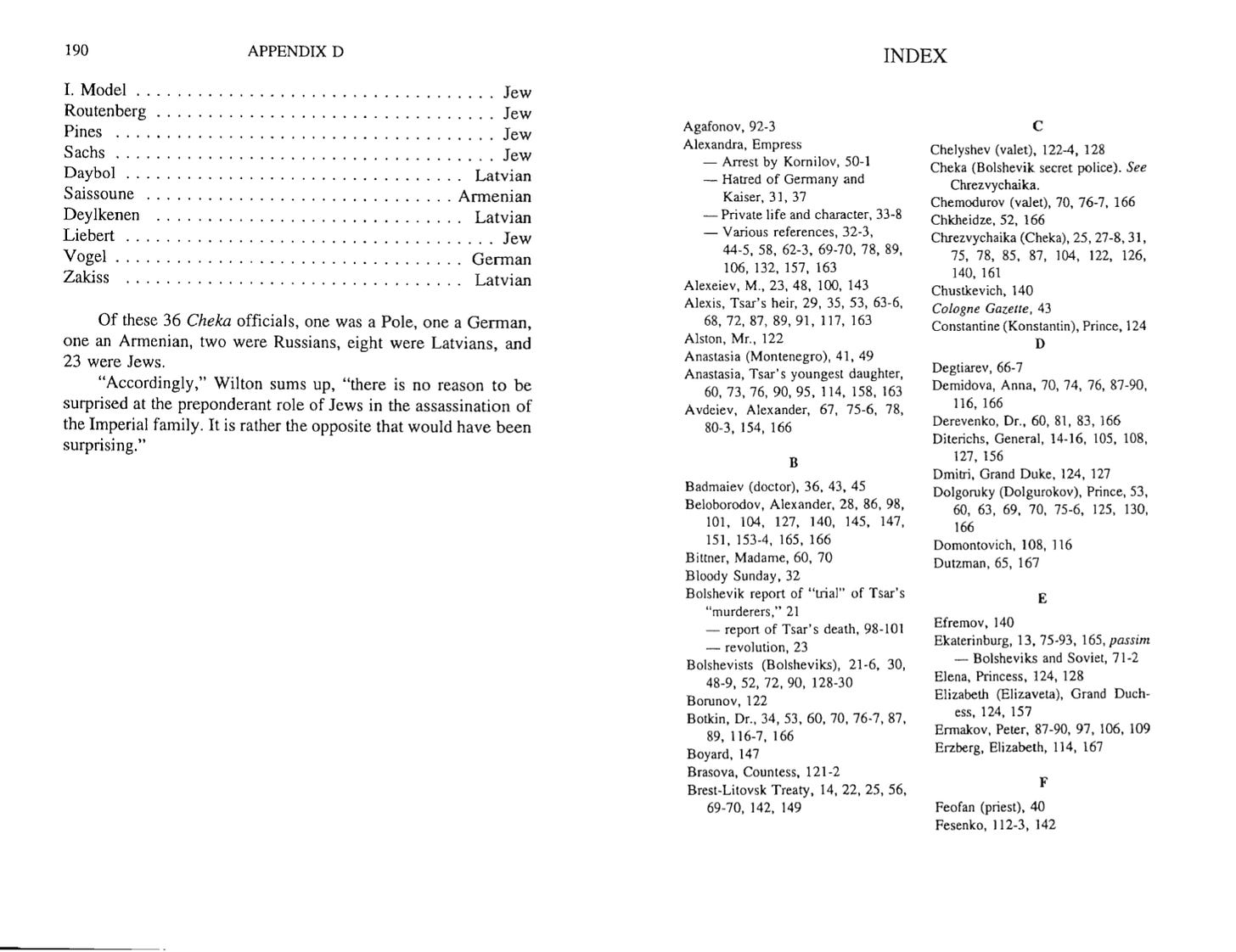
Good read, guess we've all learned that Lativo-Bolshevism was the real enemy all along, at least if we apply the logic of anti-semites to reality.
Good work